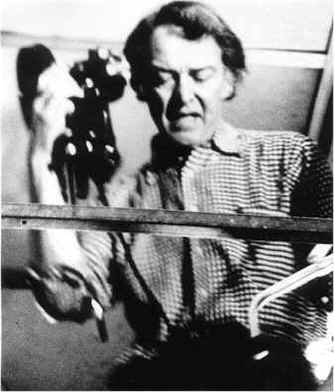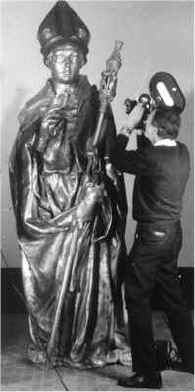


1971: Oslo, Norway, filming the
Rolf Nesch 1970: Florence, Italy, filming Clifford at 84. Photo by Anna West
Trilogy
Bronze: River of Metal
(photo by Franco Roselli)
___ . ___
View Clifford West's films
Bronze, River of
Metal,
The
Creative Journey: Arnold Blanch,
Edvard Munch: Paintings
, Edvard Munch: Graphics, Watercolors, Drawings, and Sculpture, and
Harry
Bertoia's Sculpture. The Academic Film Archive of North America continues to be active in
assisting the West family in documenting
and preserving his films. For that story, click here.
An interesting and unique body of work was filmed by artist Clifford West,
whose more than 25 films on artists and aspects of art history, made between 1958
and 1981, utilize a camera-as-brush technique more in keeping with the approach
taken by a painter than a filmmaker. West's serpentine zooms and pans
emulate the non-linear way an individual looks at a piece, as opposed to the
manner in which a more traditional cinematographer plans, then shoots, a work of
art. Many of his films on Florentine art derived from an estimated
40-50,000 feet of film shot on one trip, then edited into films on different
themes.
In addition to his Renaissance films, West made several films on modern
artists. Especially notable is Harry Bertoia’s Sculpture, with
its close-up hand-held pan and zoom making the sculpture seem more like a lunar
landscape, its purposely out-of-focus impressionist framing suddenly giving way
to a sharper, still-abstract representational image, and its utilization of
Bertoia’s own musique-concrète score (West, in fact, asked the sculptor to
bang on his work with metal objects with microphone present).
Although appearing in the permanent collections of over 150 museums, and having
his work championed by art historian H.W. Janson, among others, West’s work,
ranging in subject matter from Florentine architecture to Edvard Munch, remains
difficult to find, and worthy of a fresh look.
West was born in Cleveland, Ohio on July 4th, 1916, and began making films as an art instructor
at Michigan's Cranbrook Academy of Art, initially due to the fact that he
couldn't find appropriate film to demonstrate the concept of negative
space. He continued to paint and teach in Lebanon, New
Hampshire, in the non-profit AVA Gallery run by his wife Bente Torjusen, until
he passed away on October 22, 2006. On his passing, daughter Anna West
wrote: "At 5:50 am Clifford rode off on his horse, paintbrush in hand, into the
morning light .... His loving family was there wishing him farewell on his
journey. From time to time, look into the sky for the many beautiful murals he
has yet to paint..."
Filmography
Films prefaced with an asterisk *
are available in digital or VHS format. Please contact
us for more details.
Metamorphosis (1958)
Time - Form - Color (documenting Ossabaw Island,Georgia) (1958) A study
in plant forms, skeletal sculptures, and habitat.
The Fountain of Faith (Carl Milles) (1960?) West says Milles (who
studied with Rodin) was a hero of sorts at Cranbrook Academy in Michigan, where
West studied. Here the filmmaker takes a reverential approach in a black and
white study of the sculptor’s fountain in Falls Church, Virginia.
The Fountains of Carl Milles (1960)
Travis, Tigers, and Wild Boars (watercolorist Paul Travis) (1960?)
Berthold "Tex" Schiwetz, Sculptor (1962?)
The Creative Journey: Arnold Blanch (1964)
Here, West surveys the life and work of Arnold Blanch, showing him as a
teacher and painter in Woodstock, New Jersey.
The Basilicia of San Lorenzo (1964) Here, in the edifice built by
Brunelleschi as the Medicis’ parish church, we explore the work of Donatello,
from his bronze pulpit, to his massive doors of the sacristy.
Florentine Workshop of the Pietre Dure (1964) Shows how "paintings"
in semi-precious stones are made, using patterns, saws, and files, showcasing
the museum of Edificio de la Pietre Dure in Florence, established by the Medici
family.
* The "Davids" of Florence (1964)
* Michelangelo: The Medici Chapel (1964) In 1519, Pope Leo X
authorized the 44 year old sculptor to begin a series of seven funerary statues
in the Medici Chapel, adjacent to the Church of San Lorenzo. In 1534 he left
angrily, and never returned to completely finish them. West’s camera caresses
these forms, examining hands, faces, folds in clothing, first looking at one
sculpture, then another, then returning again, mirroring the way many of us look
at these sculptures when we visit the Medici chapel, back, forth, sideways,
backwards, settling for a few moments on one element, while another across the
room beckons.
* Harry Bertoia's Sculpture (1965) Born in Italy in 1915, Bertoia
eventually moved to Michigan, attended Cass Technical High School, where he was
introduced to metals, and moved on to the Cranbrook Academy, where he met fellow
student Clifford West. Shortly after his marriage in 1943 (West was his best
man), Bertoia moved to California at the behest of his friend Charles Eames, and
collaborated on the design of the famous ‘Eames Chair’ produced by Knoll
Associates. In the 1950s, he set up his own studio in Bally, Pennsylvania, where
he designed the well-known ‘Bertoia Chair’, also for Knoll. Soon, he was
experimenting with sculptures of different alloys and patinas, and would create
‘musique concrète’ soundscapes utilizing his sculptures. He died in 1978, a
victim, says West, of heavy metal poisoning, acquired as a result of his
constant proximity to metals and chemicals. From a cinemagraphic and
sound perspective, this is West’s most progressive film, as abstract in filmmaking
technique as the sculptures themselves. Opening with the camera slowly moving
over what appears to be the surface of the moon, it suddenly falls back to
reveal instead the texture of a sculpture. The film is one of constant motion,
resulting from the vertiginous movements of West’s camera, or the movement
built into the sculptures themselves. The music, played by Bertoia, utilizing
various objects alternately hammering or caressing his sculptures, is
reminiscent of the work of Xenakis. From the perspective of West’s career, the
film marked the beginning of a new, bolder approach to camera movement, as seen
in later films such as ‘Bronze: River of Metal’ (1972), and ‘The Art of
Rolf Nesch: Material Pictures’ (1972).
Florentine Architecture of the Renaissance (1965)
The Cathedral and the Baptistry of Florence (1965) Initially an
examination of the architecture and sculpture of the Florentine cathedral,
West's moving camera provides an intimate exploration of Michelangelo's 'The
Deposition', Ghiberti's bronze panels, and Donatello's shockingly dissolute Mary
Magdalen.
Siena (1965)
The Cantoria of Luca della Robbia (1965)
The Basicilca of Santa Croce and the Pazzi Chapel (1967) West turns to
one of the finest examples of Franciscan architecture in Italy, investigating
its exterior and interior, which includes the mural cycle of Giotto, Donatello's
Annunciation and Crucifix, and marble pulpit of Benedetto da Maiano. Standing
adjacent to the church is Brunelleschi's Pazzi Chapel where the director
investigates its architectural elements.
* Edvard Munch: Paintings (1968) Examines
the life and works of Norwegian-born artists Edvard Munch, accompanied by
excerpts from his letters and writings, and illustrates important stages of his
development with key works.
* Edvard Munch: Graphics, Watercolors, Drawings, and Sculpture
(1968) Born in 1863, the Norwegian artist watched his mother and sister
succumb to tuberculosis by the time he was fourteen, leaving him with a deep
foreboding of death, which colored his early canvases and works on paper. Munch
was also haunted by the spectre of beautiful women, who he portrayed as vampires
or dominant sexual forces, and characterized his perspective on new artistic
technology by stating: "The camera cannot compete with the brush and the
palette so long as it cannot be used in heaven or hell." Here, West looks
at drypoints, etchings, engravings, lithographs, and woodcuts, providing
examples from the artist’s oeuvre, and, just as importantly from the
perspective of the learner, explains how, mechanically, these works are created.
Most impressive are the woodcuts, and the four-stone, four color lithographs. Of
the 700 or so graphic images created in the artist’s lifetime, we explore some
of the more significant, including ‘The Scream’, ‘ Madonna’, ‘Three
Stages of Women’, and ‘Vampire’; West juxtaposes different versions of the
work, often transposing one version over another. During the making of this
film, West was guided by Munch scholar Bente Torjusen, who collaborated with him
on the making of several other films, as well as two daughters. For further
information on the artist, and for a preview of some of the images central to
the film, visit
http://www.edvard-munch.com/gallery/litho/index.htm
Romanesque Churches in Northern Italy (Tuscany) (1968) A breathtakingly
beautiful film, focusing on Sant' Atimo, near Siena, and San Mineato al Monte in
Florence, marred somewhat by the didactic, halting narration of Gilian Ford
Shallcross.
The François Vase (1969) This famed 6th century BCE vase,
painted by Kleitias, and made by Ergotimos, is adorned with tales of Achilles
and Theseus. West investigates every scene, including the battle of the pygmies
and cranes, and Ajax carrying the dead Achilles.
In Search of an Ecological Balance (1969)
Ossabaw Island Project (1969)
Give and Take (ecological subject matter) (1971)
* Bronze: River of Metal (1972) Here, West looks at the art of casting
Renaissance bronzes as a historian, appreciator, critic, and craftsman. The film
begins with historian Bruno Bearzi showing Donatello's modifications, and his 14
separate castings, on the colossal bronze of St. Louis of Toulouse at the Museo
dell'Opera. Then, a visit to the Hades-like Fonderia Ferdinando Marinelli, where
four workers prepare casts for the lost-wax process, then laboriously hoist the
heavy, molten bronze crucible, and carefully pour off its terrible contents, to
a soundtrack of ambient noise made by sculptor Harry Bertoia. Finally, the
director turns to the past, through the doors of Ghiberti in the Baptistry of
Florence.
* The Art of Rolf Nesch, A Trilogy: A Visit to Al, Graphics, Material
Pictures (each 1972) Rolf (Emil Rudolf) Nesch was born in
Germany in 1893, but fled to Norway in 1933 as a result of Nazi persecution,
remaining there until his death in 1975. In 'Material Pictures', one of a
trilogy of films made by West on the artist, we see Nesch's work evolve from
welding ribbons of material onto metal plates, resulting in bas-relief prints,
to the integration of three-dimensional forms of ceramic, glass, and metal with
paint, to form a "material picture". West's camerawork on the
massive 'Herring Catch' is a tour-de-force of art-vérité, climbing in, out,
over, and around the sculpture, dizzying and electrifying. For more on the
artist, visit: http://www.norwaypost.no/NP/culture/musnesch.html
Palazzo Medici and the Medici: A Trilogy (1981)